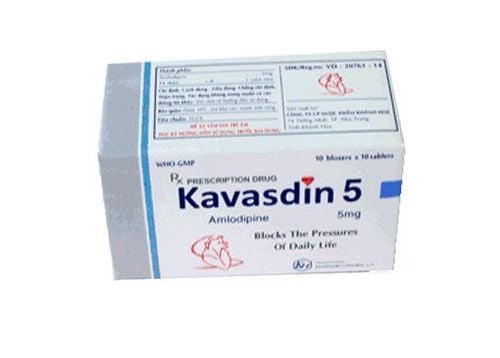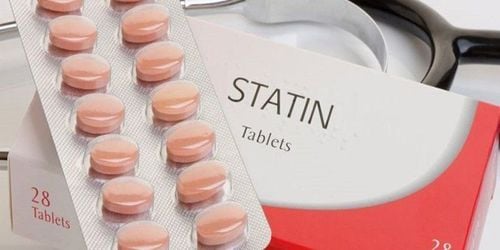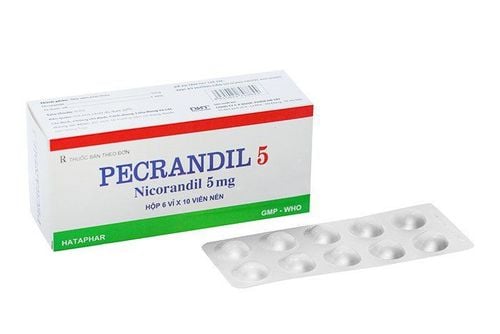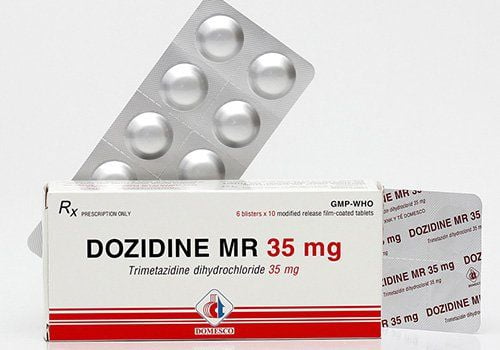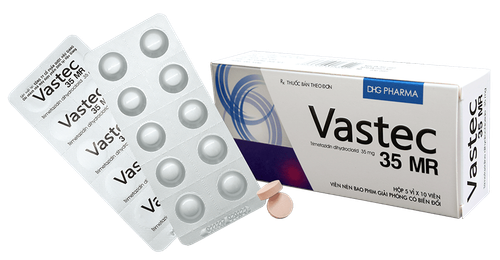This is an automatically translated article.
Tilhasan 60 has the main ingredient is Diltiazem hydrochloride, which belongs to the group of calcium channel blockers. The drug is used for the prevention and long-term treatment of angina (not indicated for acute angina attacks), mild to moderate hypertension. The drug is prepared in the form of tablets, each containing 60mg of Diltiazem hydrochloride.
1. What is Tilhasan 60?
Drug group: Cardiovascular drugs Dosage form: Film-coated tablets Packing: Box of 3 blisters x 10 film-coated tablets Ingredients: The main active ingredient is Diltiazem hydrochloride 60 mg and other excipients in sufficient quantities. . 1.1. Pharmacodynamics of the drug Tilhasan 60 Pharmaceutical substance Diltiazem is a calcium antagonist used in the treatment of angina and hypertension.
1.2. Pharmacokinetics of the drug Tilhasan 60 Diltiazem is rapidly absorbed from the gastrointestinal tract. The drug is present in the blood about 30 minutes after taking it. Peak plasma concentrations are reached 3 to 4 hours after administration. The mean plasma half-life is 4 to 8 hours. Active ingredient Diltiazem binds to plasma proteins at the rate of 80-85%. Active ingredient Diltiazem is extensively metabolised in the liver; The active metabolite is desacetyl diltiazem. The drug is excreted mainly via bile and urine. There is a significant correlation between therapeutic dose and plasma concentrations. Increasing the therapeutic dose will result in increased plasma concentrations but not saturation. When used at stable doses, plasma concentrations are also stable. There is a correlation between plasma concentrations and the potency of Tilhasan 60. The pharmacokinetics of the drug is not changed in patients with renal failure. The plasma concentrations of the drug in the elderly, people with renal failure, liver failure are usually higher than in young people. Diltiazem and its metabolites are rarely dialysed. 1.3. The effect of the active ingredient Diltiazem Tilhasan 60 inhibits the calcium influx of benzothiazepine derivatives.
Diltiazem is an active substance that inhibits the flow of calcium through the cell membrane into the myocardium and vascular smooth muscle and reduces the concentration of calcium in the cells:
Diltiazem increases coronary flow due to a decrease in resistance. The effect slows the heart rate moderately and reduces the resistance of the arteries thereby making the heart work less. The clinical efficacy of Diltiazem has been demonstrated in controlled studies in all forms of angina . 1.4 What are the effects of Tilhasan 60? Prophylactic treatment of stable and unstable angina episodes, post-myocardial infarction angina, and Prinzmetal's angina. Treatment of high blood pressure of various causes. Cardiac arrhythmias, supraventricular tachycardia, hyper-cardiovascular syndrome.
2. Usage and dosage of Tilhasan 60
2.1. How to use Tilhasan 60: Use the drug orally, before eating and at bedtime. You should not stop treatment with the drug suddenly because it can cause severe angina attacks. 2.2. Dosage of Tilhasan 60 For adults: The usual therapeutic dose is 1 tablet (60 mg) x 3 times/day. However, individual response may vary and the dosage may vary considerably from person to person. The therapeutic dose may be increased up to 360 mg/day. A high therapeutic dose of 480 mg/day has been shown to be effective in some patients with unstable angina. There is currently no evidence that the drug is less effective when used at high doses. For the elderly and people with liver and kidney failure: The recommended starting dose is 1 tablet (60mg)/time X 2 times/day. During treatment with this drug, your doctor will order regular heart rate measurements. Do not increase dose if heart rate is below 50 beats/min. Children: The efficacy and safety of Tilhasan 60 in children have not been established. It is not recommended to use the drug in children. Note: The above therapeutic dose is for reference only as recommended by the manufacturer. The specific treatment dose depends on your health condition and how advanced the disease is. For a specific and appropriate therapeutic dose, you need to consult your treating doctor or medical professional.
3. In case of missed dose or overdose of Tilhasan 60
In case of drug overdose or suspected drug overdose, you need to go to a medical facility immediately. Doctors will prescribe treatment, gastric lavage, osmotic diuretics. Conduction disturbances can be treated with temporary pacing. The doctor can treat it with atropine drugs, vasoconstrictors, inotropes, glucagon and calcium gluconate infusion. In case of missed dose: If you forget to take the medicine, take it as soon as you remember. If it is almost time for your next dose, skip the missed dose and continue with your next regular dose. Do not take a double dose to make up for the missed dose.
4. Undesirable effects of Tilhasan 60
About 30% of drug users reported adverse effects related to the vasodilator potential of Tilhasan 60. The most common manifestations are lower extremity edema, dizziness, fatigue, asthenia, insomnia, nausea, bradycardia, first degree atrioventricular block, cough.... Side effects are uncommon in clinical practice. Cardiovascular system: Tachycardia, congestive heart failure, arrhythmia, 2nd and 3rd degree AV block, angina, bundle branch block, ECG abnormalities, hypotension, palpitations chest, syncope, ventricular extrasystoles. Nervous system: Abnormal dreams, amnesia, neurasthenia, abnormal gait, hallucinations, insomnia, prolonged stress, paresthesia, dreaming, personality changes, tinnitus, sensation creepy. Digestive system: Anorexia, constipation, diarrhea, dry mouth, increased liver enzyme tests (SGOT, SGPT, LHD and alkaline phosphatase), nausea, thirst, vomiting, weight gain. .. About dermatology: Hemorrhagic spots, sensitivity to sunlight or UV rays, itching on the skin.... These symptoms are usually transient and will disappear when the drug is stopped. However, in rare cases, the skin rash will progress to erythema multiforme or exfoliative dermatitis. Other cases: Decreased vision, asthenia, increased CPK, edema, itchy eyes, headache, albuminuria, leukopenia, thrombocytopenia, hyperuricemia, hyperglycericemia, nasal congestion, rats withdrawal, stiff neck, nocturia, dental arthritis, gynecomastia, baldness, erythema multiforme, toxic epidermal necrolysis (Lyell's syndrome), exfoliative dermatitis, Stevens- Johnson, in particular, extrapyramidal syndrome (a disorder associated with spasticity, tremor, and abnormal movement), gingival hyperplasia.
5. Tilhasan 60 . drug interactions
Tilhasan 60 should be used with caution when co-administering beta-blockers, diuretics, ACE inhibitors and antihypertensive agents and should be monitored regularly because of the synergistic effect of lowering blood pressure. With alpha blockers, the doctor will prescribe close monitoring of arterial blood pressure because the drug can cause severe orthostatic hypotension. Tilhasan 60 should not be used in combination with antiarrhythmic drugs or Esmolol, beta-blockers used in people with heart failure (bisoprolol, carvedilol, metoprolol...), dantrolene (infusion), sultopride, pimozide, cisapride , reserpin. This is because they inhibit sinus rhythm and cardiac conduction by synergistic effects. Do not use in combination with dihydropyridine calcium antagonists, benzodiazepines (triazolam, midazolam (IV)), carbamazepine, theophylline, cyclosporin, imipramine, phenytoin... liver enzymes (cytochrome P450), which increase blood levels of these drugs. Therefore, it is necessary to adjust the therapeutic dose during and after the combination. Cimetidine, ranitidine or HIV protease inhibitors increase blood levels of the active ingredient Diltiazem by inhibiting cytochrome P450, resulting in decreased blood pressure and bradycardia. Rifampicin reduces the concentration of active ingredient Diltiazem in the blood due to its effect on liver enzymes.
6. Some notes when treating with Tilhasan 60
Before using Tilhasan 60 you need to carefully read the instructions for use and refer to the information below.
6.1. Contraindications of the drug Tilhasan 60 Tilhasan 60 is contraindicated in the following cases:
Sensitivity or hypersensitivity to the active ingredient Diltiazem or any of its ingredients. Sinus node failure syndrome, 2nd or 3rd degree atrioventricular block in those without a ventricular pacemaker. People with severe bradycardia (less than 40 beats/min). Patients with severe left ventricular failure with pulmonary congestion. Women who are breastfeeding and women who are pregnant or likely to become pregnant. People with congestive heart failure. Level porphyria. Heart shock. People with severe hypotension (systolic blood pressure <90 mmHg). Severe aortic stenosis. 6.2. Caution when using Tilhasan 60
Close monitoring is required in people with left ventricular failure, bradycardia, 1st degree atrioventricular block or prolongation of the PR interval on the electrocardiogram. Diltiazem plasma concentrations may be increased in the elderly and in patients with hepatic or renal impairment. Decreased inotropic, conduction and automaticity, and anesthetic-related vasodilatation may occur with the use of calcium channel blockers. Therefore, anesthesiologists should be informed who are using Tilhasan 60. Treatment with the active ingredient Diltiazem can cause mood swings, including depression. In this case, you need to consider discontinuing the drug. Diltiazem inhibits intestinal motility. Therefore, it should be used with caution in people at risk of bowel obstruction. Careful monitoring is required in people with prediabetes or latent diabetes, because of the risk of causing an increase in blood sugar. The product contains lactose: People with rare hereditary problems of lactose intolerance, people with Lapp lactase deficiency or lactose-galactose malabsorption should not take this medicine. Ability to drive and use machines: Caution should be exercised because Tilhasan 60 may cause headaches, dizziness and irritability, affecting the ability to drive vehicles or use machines. However, no research has been done yet. Pregnancy: Diltiazem is contraindicated for use in women who are pregnant or of childbearing potential but are not using effective contraception. Lactation: Diltiazem is contraindicated in nursing women. If treatment with Diltiazem is necessary, alternative breastfeeding methods should be used. Above is the complete information about the drug Diltiazem. Patients should carefully read the instructions for use before use.
Please dial HOTLINE for more information or register for an appointment HERE. Download MyVinmec app to make appointments faster and to manage your bookings easily.




